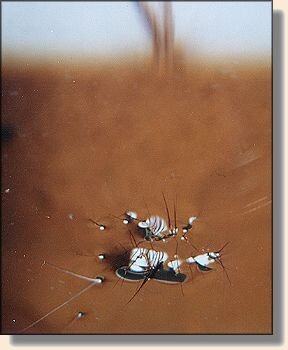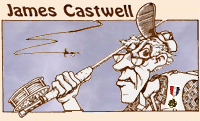|
It depends; and probably I should quit right there. That
about covers it in my opinion. I wish I could give you
more encouragement, more ammunition for the next
'shin-kickin' at your favorite watering hole discussion
on the subject. I may however be able to give you a bit
more 'grist for your mill'. At least I will try. You will
be the judge.
I have to make some observations first of the types of
dry flies we are going to be talking about. Let's start
with what I will call the conventional ones. Tails, a body,
some hackle and wings pretty much toward the front of the
fly. I will not go off into the deep water of what material
should be used for the wings. Let's just say use something
like hackle-tips of bunches of hackle. I won't differentiate
between having one post like a parachute or split or divided
wings. Just some wings. Let's agree they will be at least a
little bit taller than the hackle though.
On a conventional fly what do wings do? Let's start with
what they look like to a fish from underwater. After
all, his opinion should count for at least a little here.
I can not swear to it but it does seem that more, not less
of the flies that hatch, face downstream when they do hatch.
Not always, by a darn site, but at least a lot do.
If you are casting upstream, your tippet is tied to the
hook eye and that makes your fly face down stream. I think
this is a good idea. At least I can not think of any good
reason why it is a bad idea, so therefore it's a good one.
If you get a kink (overhand knot?) in your leader it will
change the angle of your fly as it drifts. This can be good
or bad. Just be aware that it will change something. If you
are fishing your fly across and downstream then your fly
will be drifting backwards. It will be drifting tail-first
downstream. Good thing or bad, that's up to you. Just again
be aware that these things happen, wings or not. Now let's
actually get on to the wings.
If your fly has some wings that stick up above the hackle
and is seen coming directly at the fish from upstream, as
the fly enters the fish's window of vision he will see a
big circle of hackle with a post (the wings) sticking up
from it. Remember, the natural has no big circle of hackle
facing the fish, just the (wings) post. Your call. Tie them
as you like. The natural doesn't have a hook either, but
let's not go there right now.
If your fly is turned ninety degrees either way, as the
fly again enters the window of vision the hackle and the
wing now blend and offer a more narrow view than from the
very frontal view. If all of this gets past you and drifts
downstream, again the view changes and you at least need
to be aware that all of these things can make or break a
take. Ray Bergman wrote many years ago that sometimes just
moving a few feet in either direction could bring a hit.
Many things change when you do that, including how the fly
looks to a fish.
I will mention the Marinaro thorax flies and how wings look
only because they are not obscured by the conventional method
of hackle. They (the wings) may be more important because of
that fact. As the fly enters the window of vision the only
thing seen above the surface is the wing, whether single or
split, and very discernable at that. Although slightly distorted
due to refraction they can be definitely seen and figured into
a fish's decision on taking the fly or not. Here fan wings and
other shapes start to possibly become more important. As the
true thorax' style of hackle is wound far differently, it
presents a sight picture in no way resembling that of a
conventionally tied fly.

(If you missed my writing on Thorax flies, you'll find
it HERE.)
Now we turn to one of the most important features of wings.
Do they, or do they not have any effect on presentation.
Good grief. You bet they do. Your fly line, leader and
tippet are important for presentation but, a winged fly
with a glitch in it will spin your rig into a tangled
mess beyond use. Granted there is a fly and method of
purposely casting hard and fast with a stiff leader to
spin a fly so it lands and spins to attract a fish, but
that is not the norm for sure.
Do, or could the wings act as a rudder or such a devise
as to keep the fly in a vertical orientation as it
descends? One can surely believe it can. I am one who
buys this idea fully. And the type, size and style of
wing could seriously affect this descent to the surface.
The larger they are, the more they are available to the
air, and the more they can/could slow the descent to
the water.
As the 'thorax' style of tie allows the use of one size
lighter tippet because the take of the fly is very gentle,
the wings seem to have even more influence. The lighter
tippet restricts the fly much less as it drops to the water
in comparison to a conventional tippet and fly. All of these
variables must be taken into consideration when you pose
the simple question as to "should a fly have wings."
Sometimes things are just not that simple. ~ JC
|





